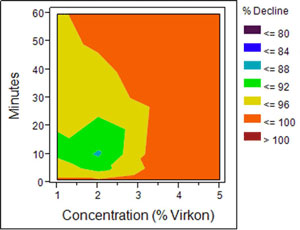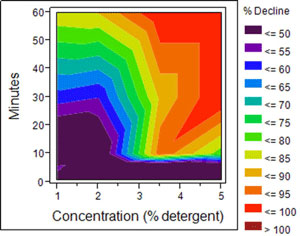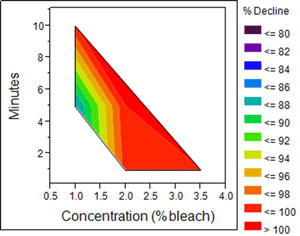Objectives
1. Determine presence/absence of Didymosphenia geminata in Great Smoky Mountains National Park as well as surrounding watershed in Eastern Tennessee.
2. Use statistical modeling to determine likelihood of Didymo invasion into GRSM waters.
3. Develop protocol for field disinfection of sampling gear to include waders and wading boots.
Introduction
Didymosphenia geminata, sometimes called rock snot, is an invasive algal diatom found in lakes, streams and rivers. Nuisance blooms of D. geminata affect the diversity, abundance, and productivity of other aquatic organisms (Kumar et al. 2008). First identified in New Zealand, Didymo was documented in Vancouver Island, British Columbia in the 1990's and has rapidly expanded eastward.In 2004, Didymo was confirmed present in the Clinch, Holston, South Holston, and the Watauga river systems in eastern Tennessee.Didymoshenia geminata is easily-transported on humans as well as waders and other fishing/ recreational gear, which has likely allowed its spread across the lower 48 in a few decades time. A more comprehensive understanding of D. germinata's habitat preferences as well as a proper method for gear disinfectant is greatly needed. Researchers at Tennessee Technological University began studies in 2014 to attempt to stem the spread of this invasive alga.
Presence and Absence

In April, July, and October 2014, sampling occurred to confirm the presence/ absence of D. geminata in Clinch, Holston, South Holston, Watauga Rivers as well as 12 sites inside or just outside the Great Smoky Mountains National Park. These included: below Fontana Lake Dam, below Calderwood Lake Dam, below Chilhowee Lake Dam, Cheoah River, Citaco Creek, East Prong Little River, Middle Prong Little Pigeon River, Middle Prong Little River, Abrams Creek, Oconaluftee River, Raven Fork, and Deep Creek. Substantial D. geminata mats were confirmed in the South Holston and Watauga rivers, moderate D. geminata mat formation in the Clinch River and a few spotty mats in the Holston River. Didymoshenia geminata was not found in any streams in the Chilhowee Reservoir or in the Great Smoky Mountains National Park streams.
Didymo invasion
While sampling for presence/ absence of D. geminata at the sites listed above, samples were taken to better understand the biology of Didymo. Drift nets were set to confirm presence/ absence of D. geminata in all sites sampled. These nets would pick up small algal diatoms and help confirm Didymo presence. After a visual confirmation of D. geminata presence at occupied sites, 5 benthic transects 10m apart were sampled. Rocks were taken from the stream bottom, transported back to the lab for later workup. Bloom coverage was estimated in the field. Habitat variables taken in the field included: water quality (temperature, pH, conductivity, and turbidity), water chemistry (calcium, magnesium, soluble reactive phosphorus, sulphate, total nitrogen), canopy coverage, channel morphology and Discharge, substrate type. Once back in the lab, drift net samples were analyzed and rocks were scraped for cell abundance counts.
In the summer of 2014, laboratory studies were conducted to determine cell abundance. There is a strong relationship between D. geminata cell abundance and pH. In a laboratory setting, algal mats were incubated in a gradient or different pH levels for 6 days. During incubation, metabolism was measured. These measurements included gross primary production, respiration, net primary production, and phosphorus uptake (NPP= GPP-R). Define GPP, R, NPP.
Results
Statistical modeling shows the best predictive model for D. geminata being soluble reactive phosphorus, total nitrogen, temperature, conductivity, pH, canopy cover, and depth. While the traditional environmental parameters for the formation of D. geminata algal mats are: a pH range of ~ 7-8, oligitrophic conditions, and light availability. Tennessee Tech's study showed open areas such as tail waters below dams that lack canopy cover, have appropriate pH which maximizes productivity, and favorable calcium levels are most susceptible to D. geminata mat formation. The large blooms that blanket the bottom of streams completely are largely correlated with sulphate availability. The lack of occupied area within and just outside of the Great Smoky Mountains National Park is possibly due to the area's geology and slightly acidic streams. These parameters may be regulating the spread of D. geminata to the park's streams.
Field Disinfection

In 2014, researchers at Tennessee Tech University conducted studies to determine the optimum disinfection agent and techniques for killing Didymo on recreational/ fishing and research equipment. The effectiveness of bleach, liquid soap, salt, and Vircon were tested at different concentrations (1-5%) and exposure times (1-60 minutes). Didymo cells were then examined to determine if the cells were still viable. This was accomplished by monitoring uptake of red stain the cells were exposed to. Basically, as a cell's viability goes up, the uptake of red stain goes up.

Although all disinfectants killed cells, bleach was more efficient in doing so. Virkon and liquid soap were also effective, but required more time and greater concentrations to achieve 100% cell death. Bleach was the most effective disinfectant. A 1% bleach solution took ~ 10 minutes while a 2% solution only took 1 minute to eliminate all D. geminata cells. Dawn detergent at a 3% solution took ~60 minutes whereas a 5% solution took 20 minutes for a 100% D. geminata elimination. Virkon at a 2% solution took ~50 minutes while a 4% solution takes 1 minute for 100% D. geminata elimination.

There are advantages and disadvantages to all three methods of disinfection. Bleach works best for D. geminata removal, but is an irritant and also breaks down the seams on waders. Detergent is mild and doesn't harm the gear, but there will be a visible trail of bubbles while fishing or working. Virkon works well, doesn't harm the person wearing the waders, but is a bit more expensive than bleach or detergent. It is current National Park Policy to disinfect any waders that have been in another watershed in a 4% Virkon solution for 1 minute.
Additional studies are currently underway to verify the results of this study as well as assess additional disinfectants. Salt and acidity were also studied, but unforeseen circumstances pertaining to red stain uptake under saline and acidic conditions prevented the study from being completed. Further work is ongoing to provide comparable assessments of saline and acidic conditions in the near future.
References:
Hix, Lucas, and Murdock, J. N. Factors Regulating the Presence and Abundance of the Invasive Alga, Didymosphenia geminata, in the Upper Tennessee River Watershed. In Prep.
Kumar, Sunil, et al. "Potential habitat distribution for the freshwater diatom Didymosphenia geminata in the continental US." Frontiers in Ecology and the Environment 7.8 (2008): 415-420.
Murdock, Justin N. Didymo Assessment and Treatment in the Chilhowee Reservoir Watershed. In Prep.
Last updated: July 20, 2015
